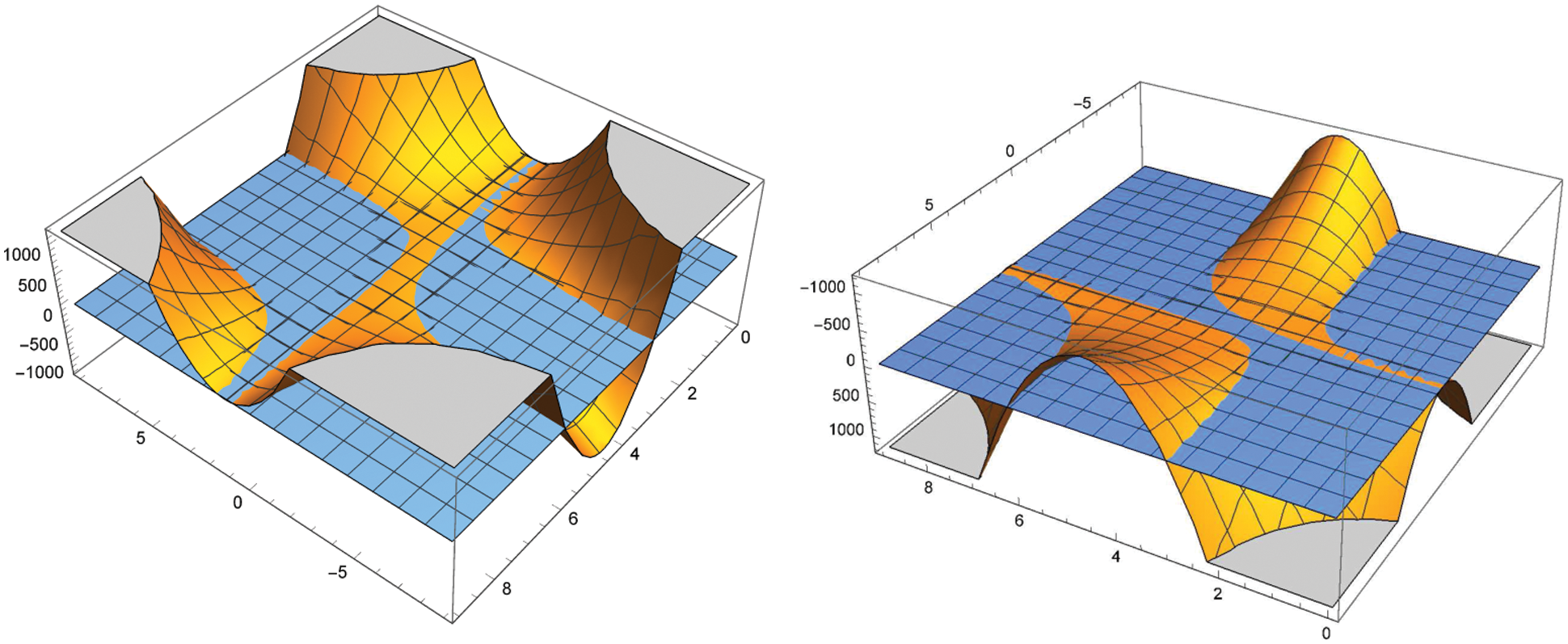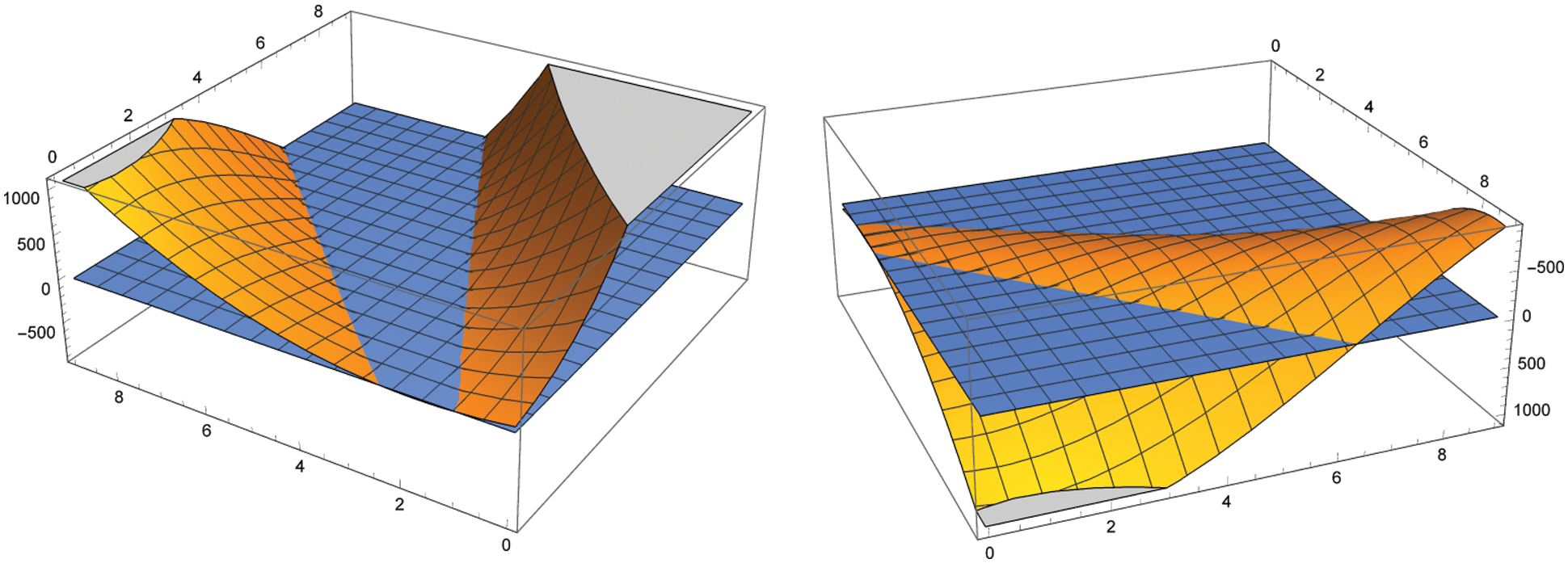

 | Computer Modeling in Engineering & Sciences |  |
DOI: 10.32604/cmes.2022.018778
ARTICLE
On Degenerate Array Type Polynomials
1Key Laboratory of Intelligent Manufacturing Technology, Inner Mongolia Minzu University, Tongliao, 028000, Inner Mongolia, China
2Department of Mathematics, Akdeniz University, Antalya, 07058, Turkey
3Institute of Mathematics, Henan Polytechnic University, Jiaozuo, 454010, China
4School of Mathematical Sciences, Tiangong University, Tianjin, 300387, China
*Corresponding Author: Feng Qi. Email: qifeng618@gmail.com
Dedicated to retired Professor Ji-Shan Tian, former vice president of Henan University, China
Received: 17 August 2021; Accepted: 27 October 2021
Abstract: In the paper, with the help of the Faá di Bruno formula and an identity of the Bell polynomials of the second kind, the authors define degenerate
Keywords: Degenerate array polynomial; Stirling number of the second kind; generating function; explicit formula; recurrence relation
In this paper, we use the following notation:
The Stirling numbers of the second kind S(n, m) for
and can be computed as
See [[1], p.206] and the paper [2].
The
See also the papers [4,5]. It is clear that S(n, m;0;1) = S(n, m). In the paper [6], Simsek obtained and constructed several generating functions and many relations of generalized Stirling type numbers, the array type polynomials, and Eulerian type polynomials. In the paper [7], Bayad et al. deduced interesting and meaningful identities associated with
In the paper [11], Carlitz introduced degenerate Bernoulli and Euler polynomials
and
respectively. For x = 0, the quantities
We now define degenerate
It is easy to see that
which is defined by (2). When x = 0, we call the quantities
In this paper, utilizing the Faá di Bruno formula and an identity of the Bell polynomials of the second kind, we establish several explicit formulas and recurrence relations of (degenerate)
Let us notice that the Faá di Bruno formula, which can be viewed as an extension of chain rule to higher derivatives, has been applied to establish explicit and closed-form formulas of many important numbers and polynomials in analytic and combinatorial number theory. For more details, please refer to, for example, the papers [12–18] and closely related references therein.
2 Some Identities of the Bell Polynomials of the Second Kind
The Bell polynomials of the second kind
See [[1], p. 134]. For
The formula
has been applied and reviewed in [[16], Lemma 2.2], [[17], Remark 6.1], and [[19], Section 1.3]. The explicit formula (8) is equivalent to
which was presented in [[20], Theorems 2.1 and 4.1], where the falling factorial
When
where extended binomial coefficient
and the classical Euler gamma function
For new results and applications about the Bell polynomials‘ of the second kind Bn, k, please refer to the papers [13,19,21–23] and closely related references therein.
3 Explicit Formulas of Degenerate
In this section, we establish two explicit formulas for degenerate
Theorem 3.1. For
Proof. Making use of
as
Remark 3.1. From (5), it follows immediately that
By virtue of the explicit formula (12), we obtain the first few values of degenerate
Remark 3.2. The explicit formula (12) in Theorem 3.1 and seven concrete values listed in Remark 3.1 reveal that degenerate
Theorem 3.2. For
Proof. For
as
as
Remark 3.3. From the generating function (5), we can easily obtain
By virtue of the explicit formula (13), we can calculate the first few values of degenerate
Remark 3.4. From the explicit formula (13) in Theorem 3.2 and the four concrete values in Remark 3.3, we conclude that degenerate
Remark 3.5. When x = 0 in Theorem 3.2, the explicit formula (13) becomes (12) in Theorem 3.1.
Remark 3.6. For further better understanding degenerate

Figure 1: Two angles of the graph of
Remark 3.7. For further better understanding degenerate

Figure 2: Two angles of the graph of
Remark 3.8. For further better understanding degenerate

Figure 3: Two angles of the graph of
4 Recurrence Relations of Degenerate
In this section, we establish several recurrence relations of degenerate
Theorem 4.1. Degenerate
Proof. From Eq. (5), it follows that
Comparing coefficients of the terms
Theorem 4.2. Degenerate
Consequently, we have
Proof. Differentiating with respect to t yields
where, on the other hand,
and
Further replacing x by
Taking
Remark 4.1. One of anonymous referees commented that the
In this paper, with the help of the Faá di Bruno formula (7) and the identity (10) for the Bell polynomials of the second kind Bn, k, we define degenerate
Acknowledgement: The authors thank the editors and anonymous referees for their careful corrections to, valuable comments on, and helpful suggestions to the original version of this paper.
Funding Statement: The first two authors, Mrs. Lan Wu and Xue-Yan Chen, were partially supported by the College Scientific Research Project of Inner Mongolia (Grant No. NJZY19156 and Grant No. NJZZ19144), by the Natural Science Foundation Project of Inner Mongolia (Grant No. 2021LHMS05030), and by the Development Plan for Young Technological Talents in Colleges and Universities of Inner Mongolia (Grant No. NJYT22051) in China.
Conflicts of Interest: The authors declare that they have no conflicts of interest to report regarding the present study.
1. Comtet, L. (1974). Advanced combinatorics: The art of finite and infinite expansions. Revised and Enlarged Edition, D. Dordrecht: Reidel Publishing Co. [Google Scholar]
2. Qi, F. (2016). Diagonal recurrence relations, inequalities, and monotonicity related to the Stirling numbers of the second kind. Mathematical Inequalities and Applications, 19(1), 313–323. DOI 10.7153/mia-19-23. [Google Scholar] [CrossRef]
3. Caki, N. P., Milovanovi, G. V. (2004). On generalized Stirling numbers and polynomials. Math Balkanica, 18(3–4), 241–248. [Google Scholar]
4. Chang, C. H., Ha, C. W. (2006). A multiplication theorem for the Lerch zeta function and explicit representations of the Bernoulli and Euler polynomials. Journal of Mathematical Analysis and Applications, 315(2), 758–767. DOI 10.1016/j.jmaa.2005.08.013. [Google Scholar] [CrossRef]
5. Simsek, Y. (2012). Interpolation function of generalized q-bernstein-type basis polynomials and applications. In: Curves and surfaces, pp. 647–662. Heidelberg: Springer. [Google Scholar]
6. Simsek, Y. (2013). Generating functions for generalized Stirling type numbers, array type polynomials, Eulerian type polynomials and their applications. Fixed Point Theory and Applications, 2013(1), 1–28. DOI 10.1186/1687-1812-2013-87. [Google Scholar] [CrossRef]
7. Bayad, A., Simsek, Y., Srivastava, H. M. (2014). Some array type polynomials associated with special numbers and polynomials. Applied Mathematics and Computation, 244, 149–157. DOI 10.1016/j.amc.2014.06.086. [Google Scholar] [CrossRef]
8. He, Y., Araci, S., Srivastava, H. M. (2016). Some new formulas for the products of the Apostol type polynomials. Advances in Difference Equations, 2016(1), 1–18. DOI 10.1186/s13662-016-1014-0. [Google Scholar] [CrossRef]
9. He, Y., Araci, S., Srivastava, H. M., Acikgoz, M. (2015). Some new identities for the Apostol–Bernoulli polynomials and the Apostol–Genocchi polynomials. Applied Mathematics and Computation, 262, 31–41. DOI 10.1016/j.amc.2015.03.132. [Google Scholar] [CrossRef]
10. Kilar, N., Simsek, Y. (2019). Identities and relations for Fubini type numbers and polynomials via generating functions and p-adic integral approach. Publications de L’Institut Mathematique, 106(120), 113–123. DOI 10.2298/PIM1920113K. [Google Scholar] [CrossRef]
11. Carlitz, L. (1979). Degenerate Stirling Bernoulli and Eulerian numbers. Utilitas Mathematica, 15, 51–88. [Google Scholar]
12. Dağlı, M. C. (2021). A new recursive formula arising from a determinantal expression for weighted Delannoy numbers. Turkish Journal of Mathematics, 45(1), 471–478. DOI 10.3906/mat-2009-92. [Google Scholar] [CrossRef]
13. Dağlı, M. C. (2021). Closed formulas and determinantal expressions for higher-order Bernoulli and Euler polynomials in terms of Stirling numbers. Revista de la Real Academia de Ciencias Exactas Físicas y Naturales Serie A Matemáticas, 115(1), 1–8. [Google Scholar]
14. Dai, L., Pan, H. (2020). Closed forms for degenerate Bernoulli polynomials. Bulletin of the Australian Mathematical Society, 101(2), 207–217. DOI 10.1017/S0004972719001266. [Google Scholar] [CrossRef]
15. Hu, S., Kim, M. S. (2018). Two closed forms for the Apostol–Bernoulli polynomials. The Ramanujan Journal, 46(1), 103–117. DOI 10.1007/s11139-017-9907-4. [Google Scholar] [CrossRef]
16. Qi, F., Čerňanová, V., Shi, X. T., Guo, B. N. (2018). Some properties of central Delannoy numbers. Journal of Computational and Applied Mathematics, 328, 101–115. DOI 10.1016/j.cam.2017.07.013. [Google Scholar] [CrossRef]
17. Qi, F., Guo, B. N. (2017). Explicit formulas for special values of the Bell polynomials of the second kind and for the Euler numbers and polynomials. Mediterranean Journal of Mathematics, 14(3), 1–14. DOI 10.1007/s00009-017-0939-1. [Google Scholar] [CrossRef]
18. Qi, F., Guo, B. N. (2016). Some determinantal expressions and recurrence relations of the Bernoulli polynomials. Mathematics, 4(4), 65. DOI 10.3390/math4040065. [Google Scholar] [CrossRef]
19. Qi, F., Niu, D. W., Lim, D., Yao, Y. H. (2020). Special values of the Bell polynomials of the second kind for some sequences and functions. Journal of Mathematical Analysis and Applications, 491(2), 124382. DOI 10.1016/j.jmaa.2020.124382. [Google Scholar] [CrossRef]
20. Qi, F., Niu, D. W., Lim, D., Guo, B. N. (2020). Closed formulas and identities for the Bell polynomials and falling factorials. Contributions to Discrete Mathematics, 15(1), 163–174. DOI 10.11575/cdm.v15i1.68111. [Google Scholar] [CrossRef]
21. Guo, B. N., Lim, D., Qi, F. (2021). Series expansions of powers of arcsine, closed forms for special values of Bell polynomials, and series representations of generalized logsine functions. AIMS Mathematics, 6(7), 7494–7517. DOI 10.3934/math.2021438. [Google Scholar] [CrossRef]
22. Qi, F., Zou, Q., Guo, B. N. (2019). The inverse of a triangular matrix and several identities of the Catalan numbers. Applicable Analysis and Discrete Mathematics, 13(2), 518–541. DOI 10.2298/AADM190118018Q. [Google Scholar] [CrossRef]
23. Wang, Y., Dağlı, M. C., Liu, X. M., Qi, F. (2021). Explicit, determinantal, and recurrent formulas of generalized Eulerian polynomials. Axioms, 10(1), 37. DOI 10.3390/axioms10010037. [Google Scholar] [CrossRef]
24. Corcino, R. B. (1999). The
25. Corcino, R. B., Corcino, C. B. (2012). The Hankel transform of generalized Bell numbers and its q-analogue. Utilitas Mathematica, 89, 297–309. [Google Scholar]
26. Corcino, R. B., Corcino, C. B., Aldema, R. (2006). Asymptotic normality of the
 | This work is licensed under a Creative Commons Attribution 4.0 International License, which permits unrestricted use, distribution, and reproduction in any medium, provided the original work is properly cited. |